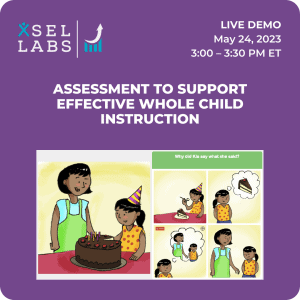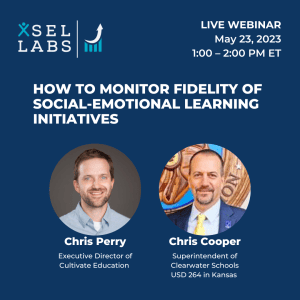Everyone is saying that social emotional learning is more important than ever, and I generally agree. But what does that mean? Why is it important? What do we do with that? As one interrupted school year winds down and we look forward to the possibility of another, how does SEL help us lessen the impact of the interruptions?
An Uninvited Experiment
We are living out a massive educational experiment, brought on by the pandemic. Here’s the question this experiment is helping us answer: When you subtract the school buildings where children and teachers meet every day, what is left of formal education?
The answer is clear. When you subtract the buildings, formal education is the sum of the relationships between educators and students and between students and each other.
This was highlighted in a recent conversation I had with a middle school principal who had established remote learning, mainly by daily Zoom connections. She noticed that in some teachers’ classrooms, attendance was nearly perfect; in others, it was really sparse.
What had happened? For the teachers who had positive relationships with their students, and who had created a sense of community and common cause, students wanted to come to class. For the teachers whose relationships with students were weaker, student motivation to attend was correspondingly weak, and it showed in the attendance numbers.
Without the physical building to contain everyone, education continued where relationships were strong.
Relationships are the new schoolhouse. And it’s not just academic learning that takes place in the relational schoolhouse.
The Relational Schoolhouse
If relationships are the actual structure in which learning takes place, they are also one of the most powerful protective factors for maintaining mental and physical health. And recent surveys suggest that the pandemic is taking a toll on mental health, with dramatically elevated rates of clinically significant anxiety and depression.
It seems natural then that community and mutual social support is a precious resource for pulling us all through these times, and continuing to learn. Social support—from adults and peers—will help protect children from the negative effects of the pandemic, just as social support protects adults from all manner of mental and physical maladies.
When school is in session, being under one roof together creates natural opportunities for community and the social support it brings. It’s true that some students are isolated and some teachers don’t have great relationships with some students. But the sheer proximity of people to one another coupled with our human inclination to connect results in community and connection when school is in session, and that is protective for most. When school is in session, community is the default. Children and adults don’t need to expend a lot of extra effort to create it—it’s just there, right in front of everyone, all the time.
Relationships = Will + Skill (Now More than Ever)
But we are quarantined. That means that the default is isolation, or at least a dramatically reduced circle of social support generally limited to immediate family. Unless adults and children make extra effort, social support—and the benefits it confers—goes way down. Extra effort means finding creative ways to connect such as by video conference, telephone, and social media. Extra effort for teachers means finding ways to strengthen the relational schoolhouse—for example, by writing personal letters to their students, a simple but powerful way to communicate care. Where social connection “was in the air” and effortless, now it requires an act of will, like a commitment to physical fitness or a healthy diet.
And it’s not just about will. Skill plays a big role too. In the normal flow of things, we know that social and emotional competencies like understanding others’ thoughts and feelings, the ability to resolve conflict, and the ability to manage strong emotions are associated with how positively children interact with each other and with adults, how well they are able to create positive and lasting relationships that are the basis of their community, and how positively they participate in and perform in school.
Social and emotional competence has always conferred advantages. I’d wager that’s truer now than ever. Not only does it take effort for children to connect with peer and adults, it takes an extra dose of competence. Zoom meetings are not perfectly synchronous, for example, which means that children have to read others especially well to engage in a smooth conversation. The abilities to initiate social interaction, and keep the interaction going, always challenging, are extra-important skills now. In the present situation, those with greater empathy will benefit from a kind of social gravity, drawing community towards them though the invisible force of understanding. It’s not hard to imagine other ways that social and emotional competence can help.
In sum, community and the social support it brings are essential and in our current predicament, it takes will and skill to keep connected to community.
Focus on Trauma or Connection?
What are we to do with the simultaneous fact of social distance and the need for community? Well, as I listen to the conversation about children’s well-being, two approaches get mentioned—trauma-informed practices and SEL. Often, the two are used interchangeably. Let’s unpack that a little and consider two distinct ways of thinking about our jobs as stewards of children’s development.
Trauma-informed practice generally refers to educational practices that acknowledge the negative impact of traumatic events on children’s development, and aspire at a minimum not to trigger traumatic reactions and at best to help children heal. Trauma and its effects are well-documented in the psychology and psychiatry literatures, and effective approaches to mitigating its negative effects are well known. The focus here is helping students with symptoms get better and in spirit, this approach conforms to a medical model of disease treatment.
Social and emotional learning generally refers to educational practices designed to equip students with the positive skills, dispositions, and attitudes that are associated with success in school and life. The focus is on helping students develop competencies such as empathy, problem-solving, self-management, and the like. We know that social and emotional competencies can be taught and when they are, they confer many benefits. The focus here is on teaching students skills and, in spirit, this conforms to an educational model of student development.
Trauma-informed practice and SEL are not totally distinct. Social and emotional competencies are associated with better mental health, for example, and so SEL supports students who have experienced trauma. Another example: trauma-informed practices may include teaching social and emotional competencies such as self-management as a means to mitigate symptoms. Both have an important place in our work to support students.
My feeling is that in this moment, we’d do well to focus on supporting student social and emotional competence as a main priority. In so doing, we equip students with the ability to create and benefit from community, which is as important now as it has ever been. In so doing, we equip students with the competencies, and the relationships, that help protect them from the negative impact of traumatic events, such as the pandemic. In so doing, we set them up for continued success when the pandemic recedes quickly in the rear-view mirror. And yes, let’s also be trauma-sensitive in this work.
What Educators Can Do
If the order of the day is to support student social and emotional development, how do we go about this? After all, we’re all improvising life right now. Here are a few thoughts about how educators might go about supporting student SEL in these weird times:
- Keep it simple. The quality of your relationship with your students is the number one priority. The number two priority is to clearly and simply teach and reinforce competencies that matter.
- Take an inventory of your relationship with your students and where needed, focus on strengthening them. Communicate in word and deed that you care and that you support them as people and learners.
- Give students meaningful opportunities to connect with you and each other.
- Help students label their emotions without judgment and teach them strategies to manage unwanted emotions. When in doubt, follow the emotion.
- Continue to teach your SEL lessons, modified as needed. Keep an eye on the competence that each lesson is designed to teach and as you modify, make sure you’re staying focused on those competencies.
- Find ways to connect school work to what your students care about. This maximizes engagement and signals to students that you care about what is important to them, thereby strengthening your relationship.
- Help parents support the competencies you are focusing on in your work with simple approaches to discussing and reinforcing those competencies at home.
- Take care of yourself! I know. I just gave you a laundry list of things to add to your already full plate. Sorry about that. Still, your well-being affects how available you are to your students, how well you connect with them, and how much they engage with you and learn from you.
In a time of great uncertainty, one thing is for sure: The strength of our relationships with one another will have an outsize impact on our well-being. It’s worth it for all of us to prioritize our relationships in the virtual schoolhouse and beyond.



